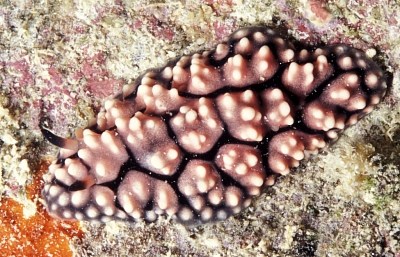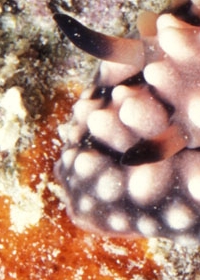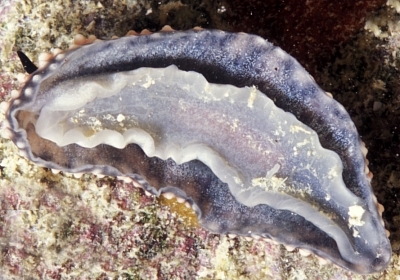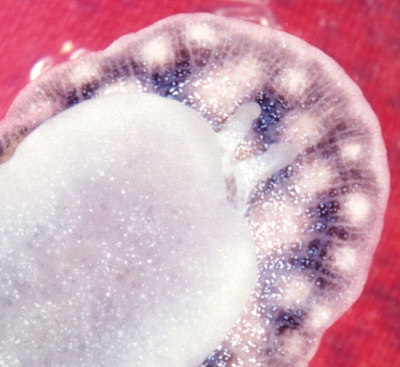Phyllidiella hageni ? from Fiji
May 21, 2007
From: Lindsay Warren

Dear Bill
Please find attached photos of this phyllidiid I found in Fiji in July 2006. My immediate reaction on seeing this specimen was that it was Phyllidiella hageni as the dorsal features (colour, tubercle arrangement, black lines) seem to fit the original description. However, this specimen lacks the thin mantle margin and the anal pocket is quite short although that could be because it is contracted.
In addition to this the oral tentacles are not tipped in black/grey (a noted feature in the original description by Fahrner & Beck); there is crosshatching on the translucent hyponotum through which one can clearly see the tubercles - neither of which were noted by Fahrner & Beck.
As a result I am confused and not at all sure what this specimen is. Perhaps you might be able to shed some much needed light. As you have said before, the phyllidiids are a very confusing group and just when it all seems clear, another one comes along to 'muddy' the waters but then it does keep the whole subject forever fascinating!
Locality: 'Zoo' divesite, Nanuya Island, 51 ft / 15.2 m, Yasawas, Fiji, Tropical Western Pacific, 24 July 2006, 10:28, Steep slope to sheer drop off, reef in excellent condition. Length: 35 mm. Photographer: Lindsay Warren.
All the best and many thanks
Lindsay
lwarren@datonomy.co.uk



Dear Lindsay,
This is a bit of a puzzle. The tri-coloured rhinophores suggest this is a species of Phyllidiopsis, and it looks like Phyllidiopsis krempfi, but the oral tentacles in Phyllidopsis are completely fused, while in your animal they are completely separate. Separate rhinophores like this are found in Phyllidiella but the rhinophores in that genus are mostly black. However two species, P. rudmani and P. lizae have pink and black rhinophores. Phyllidiella lizae is described as having rhinophores "black apically, pink centrally and white basally" which fits you animal very well. The arrangment of pustules is a bit different but that might be variability.
If its not P. lizae, I have no idea, the separate oral tentacles don't leave us with many alternatives as I am sure it is not a species of Phyllidia, Fryeria or Reticulidia which also have separate oral tentacles. I am not sure if the patch of orange sponge is of significance but a number of species of Phyllidiella, including P. granulatus, P. rudmani and P. burni have been reported feeding on orange species of the sponge genus Phakellia.
Best wishes,
Bill Rudman
Related messages
-
Phyllidiella lizae from Sulawesi
From: Sebastian Ferse, June 6, 2007 -
Phyllidiella lizae from the Coral Sea
From: Marc Saunders, October 3, 2005 -
Phyllidiella lizae from Indonesia
From: Yasman, October 5, 2003 -
Phyllidiella lizae from Vanuatu
From: Vinka Stenhouse, December 20, 1999
